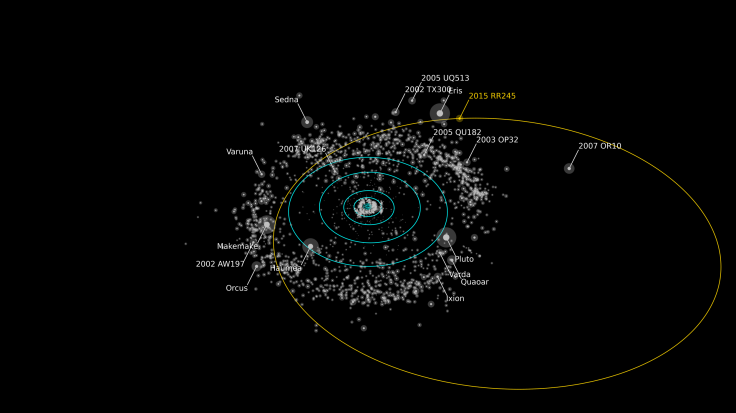New Dwarf Planet 2015 RR245 Discovered In The Far Reaches Of The Solar System

Earth has a new neighbor, albeit a really distant one. On Monday, an international team of astronomers announced the discovery of a new member of the solar system — a dwarf planet named 2015 RR245 whose huge orbit in the Kuiper Belt takes it around the sun once in over 700 years.
RR245, roughly 435 miles across, was found using the Canada-France-Hawaii Telescope on Maunakea, Hawaii, as part of the ongoing Outer Solar System Origins Survey (OSSOS) and has one of the largest orbits of any dwarf planet. At the farthest point in its orbit, the dwarf planet lies at a distance of 7.4 billion miles from the sun, as compared to Earth’s farthest point of 94.5 million miles.
Scientists first spotted RR245 in February, while sifting through OSSOS data gathered in September 2015. The dwarf planet, which has been in its current highly elliptical orbit for at least the last 100 million years, will make its closest approach in 2096, when it will come as close as three billion miles to the sun.
“The icy worlds beyond Neptune trace how the giant planets formed and then moved out from the Sun. They let us piece together the history of our Solar System. But almost all of these icy worlds are painfully small and faint,” Michele Bannister from the University of Victoria in British Columbia, a postdoctoral fellow with the survey, said in a statement. “It's really exciting to find one that's large and bright enough that we can study it in detail.”
A dwarf planet, as defined by the International Astronomical Union, is a body that orbits the sun, is nearly round, and has enough mass to have cleared its orbit. Although there may be hundreds of dwarf planets in the dark and frozen regions of the Kuiper Belt beyond Neptune and the asteroid belt between Mars and Jupiter, scientists have so far officially identified five, excluding RR245 — Ceres, Pluto, Eris, Makemake and Haumea.
“Worlds that journey far from the Sun have exotic geology with landscapes made of many different frozen materials, as the recent flyby of Pluto by the New Horizons spacecraft showed,” the researchers said in the statement. “RR245 is one of the few dwarf planets that has survived to the present day — along with Pluto and Eris, the largest known dwarf planets. RR245 now circles the Sun among the remnant population of tens of thousands of much smaller trans-Neptunian worlds, most of which orbit's is unseen.”
© Copyright IBTimes 2024. All rights reserved.






















